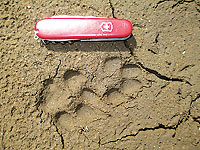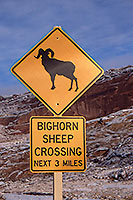Winter is a great time to look for signs of wildlife in Canyon Country. Many species are active during this time, minus the few that are slumbering the winter away such as black bears, yellow-bellied marmots, and reptiles and amphibians. Others, such as many songbirds, the original snowbirds, wing their way south to avoid winter. So even though many leave, there is still a sweet assemblage of animals to look for.
Mule deer and elk are a couple of creatures that migrate locally, moving from higher elevation to winter range where food is available and snow depth is manageable. Winter browse includes woody material such as sagebrush, bitterbrush, mountain mahogany, quaking aspen, and willow, but the bark of young pinyon pines, dried forbs, and other shrubs will round out their diet. Plant availability and nutritional needs drive these animals.
Access to winter range is also critical for their survival. South of Monticello, UDOT installed fencing along Highway 191 to channel deer and elk to passageways beneath the highway. Large culverts and bridges provide safe passage for these animals which minimize their risk of trying to outrun vehicles as the animals cross the highway. Tracks of deer and elk using these routes can easily be observed in the snow or soft ground.
 Concentrations of these ungulates on winter range attracts their primary predator: mountain lions. These secretive cats are rarely seen, but their tell-tale paw prints indicate their presence. About the size of an adult human’s palm, the tracks have rounded toes lacking extended claw marks and lobed edges on the heel pad. There are two lobes on the front edge and three lobes on the rear edge. The cats retract their claws while walking or running and rarely show these marks. Although a bit unnerving to stumble across a cougar-killed deer (because the cat may still be nearby!), these carcasses also attract another trophic level of scavengers and predators such as coyotes, foxes, ravens, magpies, and even golden or bald eagles.
Concentrations of these ungulates on winter range attracts their primary predator: mountain lions. These secretive cats are rarely seen, but their tell-tale paw prints indicate their presence. About the size of an adult human’s palm, the tracks have rounded toes lacking extended claw marks and lobed edges on the heel pad. There are two lobes on the front edge and three lobes on the rear edge. The cats retract their claws while walking or running and rarely show these marks. Although a bit unnerving to stumble across a cougar-killed deer (because the cat may still be nearby!), these carcasses also attract another trophic level of scavengers and predators such as coyotes, foxes, ravens, magpies, and even golden or bald eagles.
Bobcats are another predatory cat that occurs in the region. Smaller than a mountain lion and lacking the long tail, these cats are also secretive and rarely observed. Their smaller, quarter-sized tracks also lack claw marks and have a lobe pattern on the heel pad similar to that of a cougar.
Adult bobcats weigh an average of around 20 pounds in the wild and prey upon small rodents and rabbits. Finding an area with an abundance of cottontail or jackrabbit tracks may turn up the tracks of a stalking bobcat. A rabbit’s track pattern is in the shape of the number 7, with the two hind feet side by side and the two front feet offset in a line.
The small tracks of mice and woodrats might be harder to identify to species, but do indicate that a lot of these animals are still active in winter. Grassy or shrubby areas are good spots to look for these “track highways.” Plunge holes indicate where these rodents burrowed under the snow.
So even though viewing wildlife in the desert can be challenging anytime during the year, observing tracks or scat is a great way to enjoy wildlife in winter.